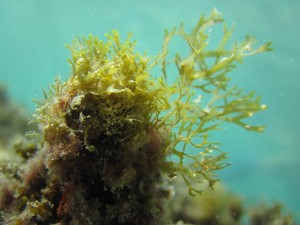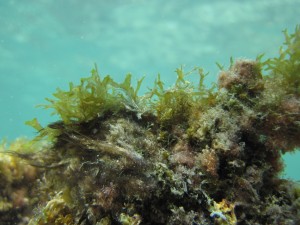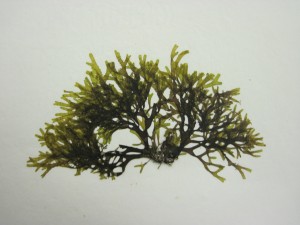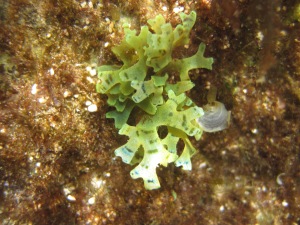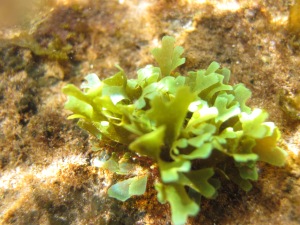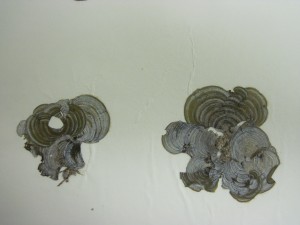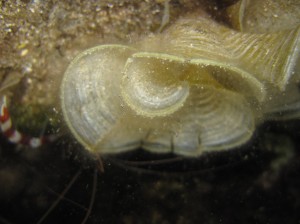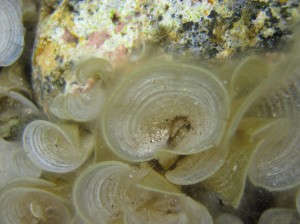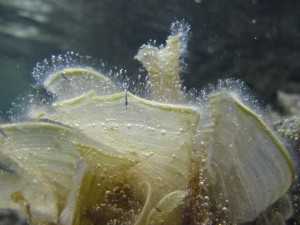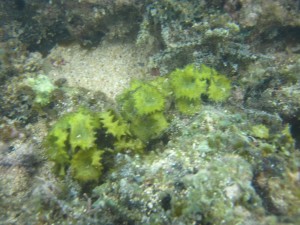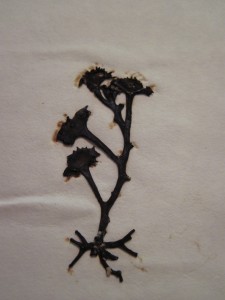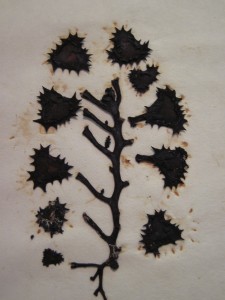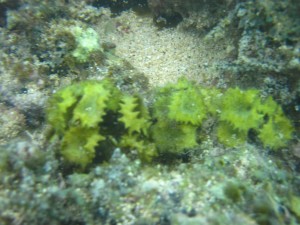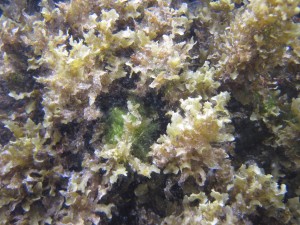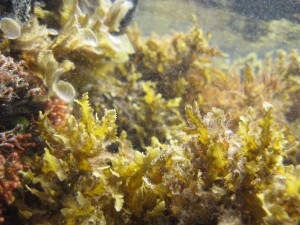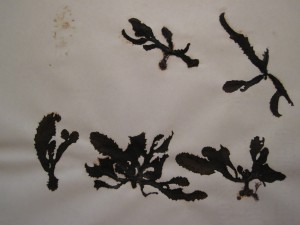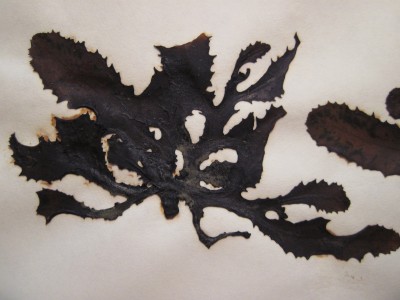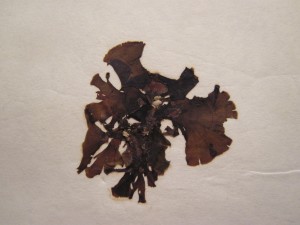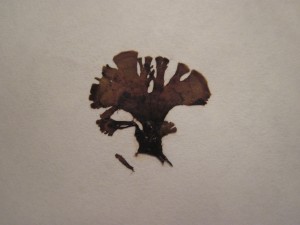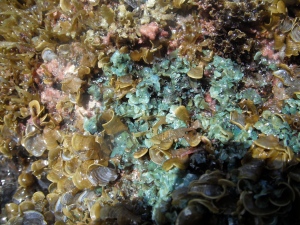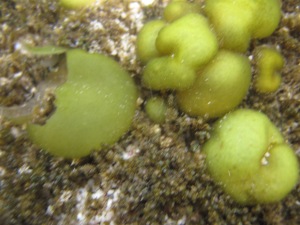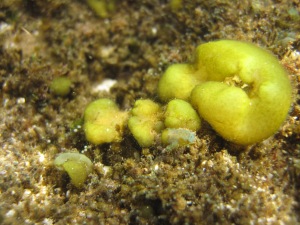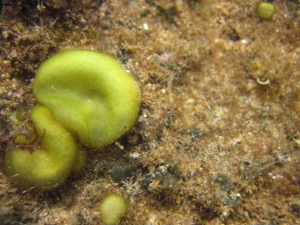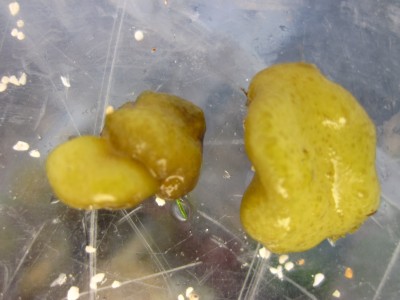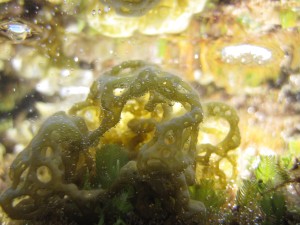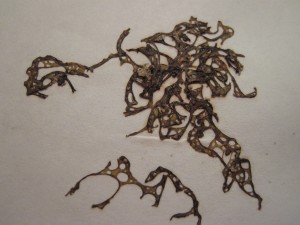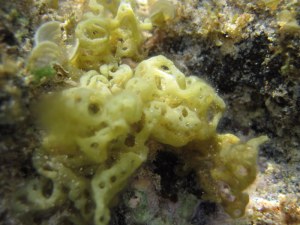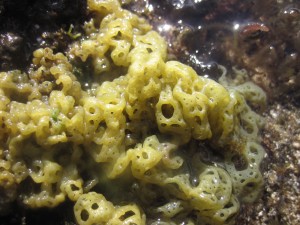Phaeophyta, brown algae, are most abundant in temperate waters and are mainly represented by the kelp’s which are the largest and most conspicuous of all marine plants. Out of all known species, 99% are marine with the remaining 1% being found in freshwater ecosystems. The majority of brown algae found in the Hawaiian Islands are smaller and much less conspicuous but can form very dense beds along the bottom. There are 62 species that represent this division of macroalgae in Hawai’i. They grow very near to shore and are typically attached right to the substrate. These algae show varying shades of brown as their color and even though they contain the chlorophyll pigments that allow for a green color, it is generally masked by the brown pigments.
Dictyota spp
Species in this genus are very hard to identify because they all have similarly forked branches. They can form dense mats in most reef environments where they grow attached to rocky substrates, around coral heads, and on vertical wall faces. They are very common in areas that are protected from strong wave energy. There are eight species of Dictyota found in the Hawaiian Islands.
Dictyota sandvicensis
This is one of the most common species of algae found on reef flats and is also the only species of Dictyota that is endemic to Hawai’i. It has a yellow-green iridescence and wide Y-shaped branch tips.
(Top right and bottom left pictures credited to Heather Hillard)
Padina spp
Padina is a wide spread and easily recognizable species. There are 7 species found in Hawaii and all are characterized by a fan shaped thallus that is lightly calcified. The reproductive structures occur as dark bands on the surface of the fans, which can also help to characterize a species. Various other characteristics help distinguish the species including outward appearance, location of sporangia and whether the sporangia are naked or have a coating.
(Middle left photo credited to Heather Hillard)
Turbinaria ornata
This is the only species of Turbinaria that is represented in the Hawaiian Islands. The plants have creeping roots and distinct top shaped branches. Juvenile forms can look nothing like the adults, showing only the root like bases and not the tops. The upright branches are stiff and have spines protruding out along the margins. The reproductive structures are found in clusters along the upright axis and below the top-shaped branches. It grows in the mid-intertidal range to at least 30 meters of depth and is a common and abundant alga found on many reef flats.
Sargassum spp
Sargassum is one of the most structurally complex of the brown algae with a plant body containing a distinct stem and leaf-like branchlets. In Hawai’i there are only five species of Sargassum, four of which are endemic.
Sargassum echinocarpum
This species is often abundant in mid to low rocky intertidal areas with moderate wave action and on reef flats. Despite being present year round, it has been observed that the population is more dense during winter and spring, especially on shores exposed to winter storm waves. To the Hawaiians Sargassum echinocarpum is known as limu kala and was used by ancient Hawaiians as food, medicine and in special ceremonies. It is significant in the ritual of ho’oponopono, which means “to set right”. Participants hold blades of limu as they discuss and resolve conflicts. It is a way of cleansing the mind and heart so that each party will be more willing to strive for forgiveness.
Stypopodium flablliforme
This is the only form of Sypopodium that can be found in Hawai’i. It grows in the low to mid intertidal and on reef flats with depths down to 30 meters. Its is widespread in tropical waters, distributed throughout the Indian Ocean and the western and central portions of the Pacific Ocean. When viewed underwater it has an iridescent blue sheen, but when removed from the water it reverts back to a dark brown color. The thallus is fan-shaped and resembles Padina except it lacks the calcification that Padina has.
Top photos are images of dried and pressed Stypopodium showing the dark brown color that it reverts to when out of water. The bottom photo shows the blue iridescent when viewed in the water, it is also surrounded by Padina where you can see how the structure is similar but the Stypopodium lacks the calcium carbonate that makes up the Padina.
(Bottom photo credited to Adam Becker)
Colpomenia spp
Colpomenia is represented in Hawai’i by two species, Colpomenia sinuosa and Colpomenia tuberculata. Colpomenia tuberculata is rare so if you encounter this genus, you will most likely be seeing Colpomenia sinuosa. These plants are light brown, irregularly lobed and mostly hollow.
Colpomenia sinuosa
This species is typically found on reef flats and up into the intertidal. It can be epiphytic or epilithic and growing in water as deep as 20 meters. It is widely distributed in subtropical and warm temperate waters. The size can range from 10-12 cm in diameter.
(Top two and bottom left photo credited to Heather Hillard)
Hydroclathrus spp
There are two species of Hydroclathurus found in Hawai’i, Hydroclathrus clathratus and Hydroclathrus tummulis. This genus is distinctive because of its light brown saccate body and numerous perforations. In some species the perforations can take on a net-like appearance in older plants. Hydroclathrus tummulis is a relatively newly described species and is currently only found in the Northwestern Hawaiian Islands.
Hydroclathrus clathratus
This is the most commonly encountered species of this genus in the main Hawaiian Islands. It grows in a variety of different habitats from the upper intertidal pools to the deep subtidal. It can be epiphytic but is mostly seen growing on rocks. Its unusual morphology makes it fairly conspicuous on the reef.

